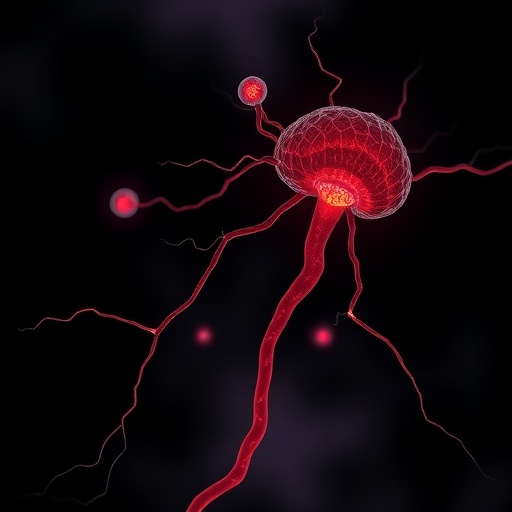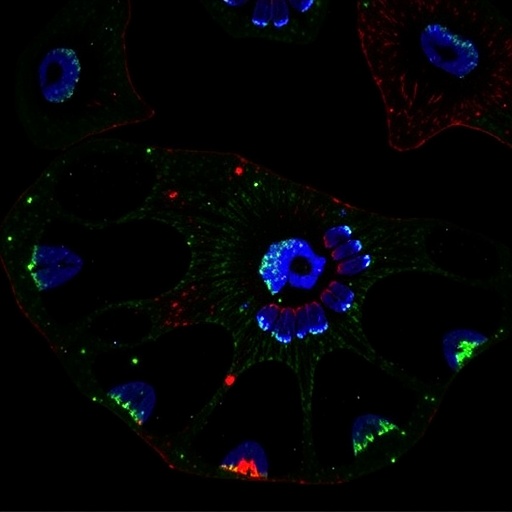In the intricate machinery of human biology, the propagation of genetic mutations plays a pivotal role in shaping both health and disease. A striking dimension of this genetic instability unfolds in renewing tissues, where mutations bestowing selective advantages spark clonal expansions, altering cellular landscapes in profound ways. However, unlike in most somatic tissues, mutations driving these expansions within spermatogonia—the progenitor cells of sperm—carry a unique significance: they are inherited by subsequent generations. This discovery, stemming from a groundbreaking study by Seplyarskiy et al., illuminates previously uncharted complexities in human germline mutagenesis and its evolutionary consequences.
Renewing tissues are characterized by ongoing cell division, a process that, while essential, is vulnerable to accruing mutations. Typically, these mutations result in clonal expansions—populations of cells that share a genetic alteration conferring growth advantages. Yet, these expansions in somatic tissues affect only the individual in which they arise, with no direct influence on offspring. Spermatogonia stand apart in this respect: because they are the origin of sperm cells, mutations arising here can be passed directly to progeny, magnifying their impact beyond the individual and into evolutionary trajectories.
The concept of clonal expansions in spermatogonia (CES) was initially observed through the lens of genetic disorders exhibiting pronounced paternal age effects, such as Apert syndrome. In these cases, specific mutations were found to recur at unusually high frequencies in offspring, implicating positive selection acting on spermatogonial lineages. Seplyarskiy and colleagues have undertaken an ambitious, large-scale examination of human trios—comprising parents and their child—to systematically identify CES drivers, pinpointing hotspots of de novo mutations that signal selective clonal expansions in the male germline.
Their extensive analysis encompassed 54,715 trios affected by rare genetic conditions, alongside 6,065 control trios and population-scale genetic variation data from over 800,000 mostly healthy individuals. This colossal dataset allowed the researchers to detect genes exhibiting mutation rates deviating markedly from expectations under standard disease models. Such deviations indicate loci where clonal selection intensifies the mutation burden transmitted to offspring, a phenomenon profoundly influencing human genetic diversity and disease prevalence.
Intriguingly, the study identifies 23 genes with exceptionally high loss-of-function mutation rates—dubbed candidate CES drivers—implying that clonal expansions selectively amplify mutations that disrupt gene function. Complementing this, an additional set of 17 genes displays hotspots of gain-of-function missense mutations, suggesting that CES can manifest through diverse molecular mechanisms, including alterations that introduce novel or enhanced protein activities. These dual pathways underscore the multifaceted nature of clonal dynamics in spermatogonial cells.
Quantitatively, the impact of CES is staggering. For loss-of-function genes, the mutation rate is elevated approximately 17-fold in both control populations and sperm samples, while gain-of-function mutations at identified hotspots exhibit an amplification on the order of 500-fold in sperm. This dramatic increase underscores the powerful selective forces operating within the male germline, magnifying certain mutations’ presence far beyond random expectation and thereby shaping the genetic landscape of human populations.
The implications extend deeply into human health. Positive selection in the male germline not only escalates the prevalence of specific genetic disorders but also confounds traditional views of natural selection’s role in purging deleterious mutations. These clonal expansions elevate mutation frequencies, potentially camouflaging the action of negative selection and complicating efforts to delineate disease causation from genetic variation. Indeed, while numerous candidate CES drivers display elevated mutation rates, only a subset are convincingly implicated in disease, highlighting the need for cautious interpretation.
Moreover, this research sheds light on the broader evolutionary consequences of germline mutation dynamics. The transmission of mutations from spermatogonial expansions introduces a potent mechanism by which genetic variation can accelerate within populations, fueling evolutionary innovation while concurrently raising disease risk. By illuminating these processes, Seplyarskiy et al. contribute a vital perspective to our understanding of human evolution, genetic diversity, and disease emergence.
Technically, the study employs rigorous statistical frameworks to distinguish true hotspots of mutation—a task complicated by the heterogeneous nature of mutation processes and selection across the genome. It integrates de novo mutation data with population variation and disease ascertainment models, enabling the disentanglement of genuine clonal expansions from confounding factors such as demographic history or sequencing artefacts. This methodological sophistication underpins the robustness of their conclusions.
The discovery of CES drivers as hotspots of mutation also invites re-examination of paternal age effects on disease risk. Since clonal expansions amplify deleterious mutations in the germline over time, older fathers may contribute disproportionately to the genetic burden passed to their offspring. This insight has important ramifications for genetic counseling, public health policy, and reproductive decision-making, framing paternal age not merely as a risk factor but as a marker of elevated clonal activity within spermatogonia.
Yet, despite these advances, many questions remain unresolved. The mechanistic underpinnings of how specific mutations confer selective advantage within spermatogonia—whether via enhanced proliferation, survival, or other cellular traits—require deeper exploration. Additionally, the interplay between somatic mutation processes, germline dynamics, and environmental influences demands further elucidation to fully grasp how mutagenesis shapes human biology.
This study heralds a paradigm shift in our understanding of human mutational processes. By illuminating the hidden clonal expansions within the male germline, it establishes mutation hotspots as critical drivers of genetic variation and disease risk. As whole-genome sequencing technologies and population genetic analyses continue to advance, the landscape mapped by Seplyarskiy and colleagues will serve as a foundational framework to navigate the complexities of human heredity, evolution, and health.
In essence, the work underscores a powerful evolutionary engine operating within the very cells that give rise to the next generation. Through the lens of clonal selection and expansion in spermatogonia, the genome is not merely a static code but a dynamic, evolving entity shaped by both chance and selection—a revelation that will resonate profoundly across genetics, medicine, and evolutionary biology.
Subject of Research:
Clonal expansions in human spermatogonia and their impact on mutation rates, genetic disease prevalence, and human evolution.
Article Title:
Hotspots of human mutation point to clonal expansions in spermatogonia.
Article References:
Seplyarskiy, V., Moldovan, M.A., Koch, E. et al. Hotspots of human mutation point to clonal expansions in spermatogonia. Nature (2025). https://doi.org/10.1038/s41586-025-09579-7
Image Credits:
AI Generated
Tags: clonal expansions in renewing tissuesevolutionary consequences of mutationsgenetic disorders and spermatogoniagenetic mutations in reproductive cellsgermline mutagenesis in humanshuman biology and mutation hotspotsimplications of clonal expansionsinherited genetic mutationsreproductive biology and geneticsselective advantages in cell proliferationspermatogenesis and genetic diversityspermatogonia clonal growth





